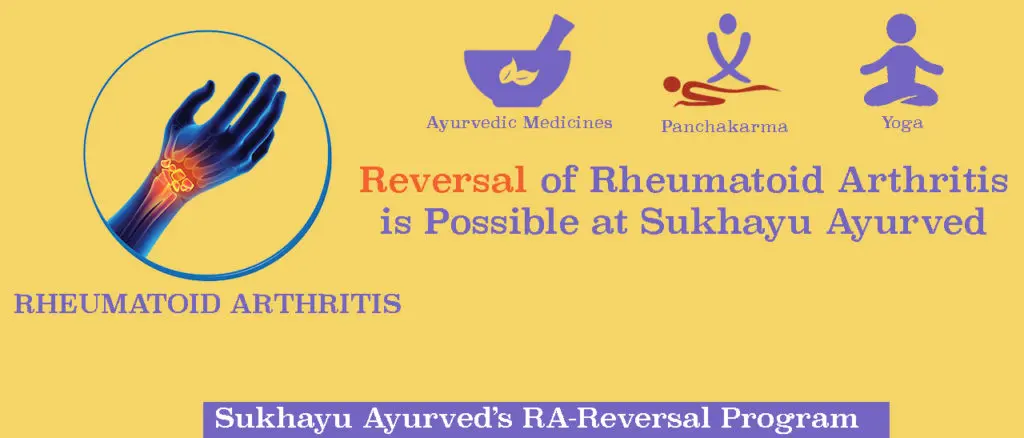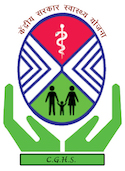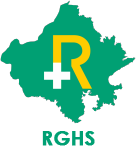Rheumatoid arthritis is a condition that impacts the smaller as well as the bigger joints. This is a condition related to the immune system. Pain, swelling, and stiffness cause physical disability. Every day, pain keeps biting all the joints. And even painkillers stop working over time. The body becomes resistant to all medicines. When the pain subsides with medicines, even though this disease keeps on eating the joints and cartilage. And final fate is- disability for this disease. But you can change the fate of your body with Ayurveda. Once we opt for the best ayurvedic treatment for rheumatoid arthritis, it not only ensures saving your joints but also helps in ensuring a “medicine-free” life.
Amazingly, with Vaidya Pardeep Ji we at Sukhayu have witnessed the RA factor being negative in several patients, and the disease never came back! Here we are discussing all the details about the disease and its best Ayurvedic treatment for rheumatoid arthritis in India.
The medicines utilized in allopathy for the treatment of rheumatoid arthritis have a high potential for negative effects. HCQs, for example, are well-known for adverse effects such as “hearing loss.” Immunosuppressant medicines can cause kidney and liver damage. However, this Ayurvedic therapy for rheumatoid arthritis in India is virtually free of side effects.

Rheumatoid arthritis is a systemic autoimmune disease; the body’s own immune system attacks its joints and causes inflammation, pain, swelling, and stiffness all over the body. In some cases, rheumatoid arthritis can cause a joint deformity as well. This disease occurs more commonly in women than in men! Although rheumatoid arthritis attacks people of all ages, it often appears first in women between the ages of 20 and 40.
Rheumatoid arthritis is a progressive inflammatory disease that causes pain, swelling, and stiffness of joints. As the disease progresses, it decreases the movement of joints. This condition affects not only joints but also other body systems, including the eyes, lungs, heart, blood vessels, and skin.
Vaidya Ji on Rheumatoid Arthritis

With Ayurveda, you can stay healthy with Rheumatoid Arthritis. Nothing to worry about the disease. This is Ayurveda which can not only negative all the reports but can surely help you to lead a normal life.
- Ayurvedic Treatment of Rheumatoid Arthritis helps in bringing the immune system to normal.
- This will help you to lead a normal life.
- Likewise severe side effects of allopathy medicines, Ayurveda is completely safe.
- After a particular time, your medicines will stop completely and you can lead to a normal life.
Ayurveda About Rheumatoid Arthritis
The most common analogy of Rheumatoid Arthritis is done with “Aam-Vata” in Ayurveda. Aam-Vata is similar to RA because of signs and symptoms and pathology.
Aam-Vata has two words- Aam and Vata. Aam is all about the toxins and Vata is about the dosha, which involves the toxins. When these come together, toxins settle down in the joints and cause all the problems.
The most complicated thing with Aam Vata is- these two components are quite opposite to each other because of the same, this condition becomes challenging in treatment.
Understanding Aamvata
To better understand the perspective of Ayurveda about the treatment of Rheumatoid arthritis, we need to know about the condition. So that we can understand the approach of Ayurvedic treatment.
Vata needs clear passage for the movements and Aam is sticky. Because of its nature, Aam blocks the passages where Vata moves freely. Vata is destructive in nature, therefore once blocked
Initially, the symptoms appear like those of indigestion. In this condition, the disease process has just begun and the morbidity has not reached the joints. These symptoms are:
- अंगमर्द – pain in body parts, general body ache
- अरुचि – anorexia, tastelessness
- तृष्णा – thirst
- आलस्य – lethargy, weakness
- गौरव – heaviness of the body
- ज्वर – fever
- अपाक – indigestion
- शूनता – swelling of body parts
With chronicity, things keep on changing and different symptoms start appearing in different body parts. As per Ayurveda, the changes in the digestive system are more evident in this condition. Here are the symptoms of the chronic stage of the Aam Vata.
- सरुजा शोफ – Painful swelling in all joints.
- वृश्चिकदंशवत पीड़ा – Severe, acute pain like scorpion bite/
- अग्नि दौर्बल्य – Low digestion and metabolism.
- प्रसेक, अरुचि गौरवम – Anorexia, leading to fullness of abdomen and excessive salivary secretion.
- उत्साह हानि – Low enthusiasm
- वैस्वर्यम– Bad taste in mouth
- दाह – burning sensation
- बहुमूत्रता – Excessive urination.
- ग्रहणी दोष – Irritable bowel syndrome like conditions, with episodes of constipation and diarrhoea
- कुक्षिकठिनता, शूल – Bloated abdomen with colic pain
- निद्रा विपर्यय – Sleepless in night and urge of sleep in day hours
- तृष्णा, छर्दि – Excessive thirst and vomiting
- भ्रम, मूर्छा, हृदगृहम – giddiness, syncope and heaviness in chest
- आंत्रकूजन, आनाह– Flatulence and gurgling sounds in abdomen
So it is clear that Ayurveda understands the disease properly. And therefore, Ayurveda too has a proper solution for the problem. NOw we will discuss the treatment part of rheumatoid arthritis.
Ayurvedic Treatment for Rheumatoid Arthritis
Because of the nature of the disease, it is important to control this condition, immediately. When this condition becomes chronic, it becomes hard to control it. Therefore, you should opt for Ayurvedic treatment of rheumatoid arthritis at the earliest.
Now we know that RA is not just another joint disease, it is more than that. As per Ayurveda the system is disturbed in this condition and we need to repair the immune system. So that the toxins from the body will be released and won’t harm the joints further. This is completed in the three steps-
- Bringing back the Agni to normal. (Deepana)
- Removal of ama (toxins) from the body. (Paachan)
- Elimination of entrapped Vata from joints. (Shodhan)
These three steps when done with precision help in the Best Ayurvedic Treatment for Rheumatoid Arthritis In India.
Bringing back the Agni to Normal
Agni is the internal capacity of the body to burn foods and stored items. This basically represents the metabolism of the body. When food converts from one level to another level (dhatu), this process when breaks- produces Ama. And this happens amid of the low strength of the Agni.
Hence, we need to work on the Agni, primarily. So that further production of the Ama will reduce with time. This helps in stopping the progression of disease. And especially in cases of stages 1 and 2, the only first step helps in the treatment of the condition.
You can opt for this step- after online video consultation.
Foods that are bad for Rheumatoid Arthritis
Removal of toxins from the body
Once we stop the production of the Ama by bringing the Agni to its best level. Now the main requirement is to – remove the toxins from the body. Without the removal of the toxins, it is not possible to get rid of the disease.
In some cases of stage 2, and in all cases of stages 3 and 4, this process is needed. So panchakarma is a basic requirement for this condition.
In Panchakarma, we generally do the following process-
- Snigdha Virechana or
- Basti Treatment
These two treatments help to get rid of the deep-seated toxins. In stage 4, more extensive panchakarma therapies are needed. These procedures for Ayurvedic treatment of rheumatoid arthritis are only possible in intensive panchakarma care, and for this, we need to admit the patient.
Elimination of entrapped Vata from joints
Without this step, we cannot save the joints. Because the nature of the RA is to destroy the joints. This happens because vata traps due to blockage of channels with Ama.
Once we have stopped the production of the Ama and have removed the toxins from the body- we need to work on the samanya gati of the Vata dosha.
Therefore we give particular medicines, which helps a patient to get back the wellness of the joints.
Process of Ayurvedic treatment for rheumatoid arthritis
To start the treatment you need to fill the form first of all. And we will need the following reports from your side-
- CBC (Complete Blood Count)
- ESR
- C Reactive Protein
- RA Factor (Quantitative)
- Liver Function Test
These reports should not be older than 2 months, from the date of consultation.
Once you have shared all the details with us, our team will guide you for the available slots for Video Consultation. So that you can consult with Vaidya Pardeep about all your problems.
If your case will be like- solving with medicines. Vaidya Ji will guide you accordingly and if there will be some requirement of Panchakarma- you will be updated about that.
Therefore all the treatment processes will be according to your requirement. There are only a few cases who need to come and admit with us for Intensive Panchakarma Care. So you need not worry about all this.
The total duration of the Ayurveda treatment for rheumatoid arthritis depends on the condition of the patient and severity of the case. There are certain cases, which need only 5 to 6 months of treatment. But in certain cases, it might take as long as 18 months. So there is no rule of the days and timeline.













